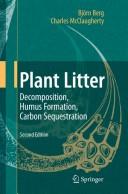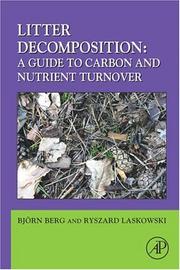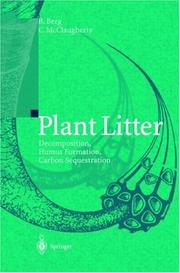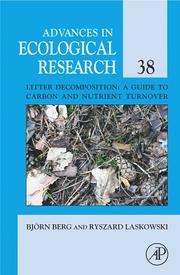| Listing 1 - 10 of 34 | << page >> |
Sort by
|

ISBN: 1281133701 9786611133702 3540749233 Year: 2008 Publisher: Berlin, Heidelberg : Springer Berlin Heidelberg : Imprint: Springer,
Abstract | Keywords | Export | Availability | Bookmark
 Loading...
Loading...Choose an application
- Reference Manager
- EndNote
- RefWorks (Direct export to RefWorks)
This fully revised and updated 2nd edition of Plant Litter focuses on decomposition processes in natural terrestrial systems such as boreal and temperate forests. The availability of several long-term studies from these forest types allows a more in-depth approach to the later stages of decomposition as well as to humus formation. It further briefly explores how processes are modified due to anthropogenic influences. Earlier findings are re-evaluated in light of recent research and with relevance to current areas of investigation. New concepts that modify or go beyond those already presented are covered and a new chapter on patterns of decomposition and accumulation on a regional scale was introduced.
Plant litter --- Humification. --- Carbon sequestration. --- Soil ecology. --- Biodegradation. --- Edaphology --- Ecology --- Soils --- Roots (Botany) --- Carbon capture and storage --- Carbon dioxide sequestration --- CCS (Carbon sequestration) --- Sequestration (Chemistry) --- Humus --- Humus formation --- Biodegradation --- Soil formation --- Environmental aspects --- Formation --- Ecology. --- Nature Conservation. --- Botany. --- Microbiology. --- Geoecology/Natural Processes. --- Plant Sciences. --- Conservation of nature --- Nature --- Nature protection --- Protection of nature --- Conservation of natural resources --- Applied ecology --- Conservation biology --- Endangered ecosystems --- Natural areas --- Balance of nature --- Biology --- Bionomics --- Ecological processes --- Ecological science --- Ecological sciences --- Environment --- Environmental biology --- Oecology --- Environmental sciences --- Population biology --- Microbial biology --- Microorganisms --- Botanical science --- Phytobiology --- Phytography --- Phytology --- Plant biology --- Plant science --- Natural history --- Plants --- Conservation --- Ecology . --- Geoecology. --- Environmental geology. --- Nature conservation. --- Plant science. --- Geoecology --- Environmental protection --- Physical geology --- Floristic botany

ISBN: 9780123736178 012373617X Year: 2006 Publisher: Amsterdam Elsevier
Abstract | Keywords | Export | Availability | Bookmark
 Loading...
Loading...Choose an application
- Reference Manager
- EndNote
- RefWorks (Direct export to RefWorks)
General ecology and biosociology --- EAR Earth Sciences --- pedology --- litter --- decomposition --- carbon --- nutrients
Book
ISBN: 3642388205 3642388213 130654422X Year: 2014 Publisher: Heidelberg, Germany : Springer,
Abstract | Keywords | Export | Availability | Bookmark
 Loading...
Loading...Choose an application
- Reference Manager
- EndNote
- RefWorks (Direct export to RefWorks)
Since the publication of the 2nd edition, there have been substantial developments in the field of litter decomposition. This fully revised and updated 3rd edition of Plant Litter reflects and discusses new findings and re-evaluates earlier ones in light of recent research and with regard to current areas of investigation. The availability of several long-term studies allows a more in-depth approach to decomposition patterns and to the later stages of decomposition, as well as to humus formation and accumulation. The latest information focuses on three fields: (i) the effects of manganese on decomposition and possibly on carbon sequestration, (ii) new findings on decomposition dynamics, and (iii) the new analytical technique using 13C-NMR. .
Botany. --- Ecology. --- Life sciences. --- Microbiology. --- Nature conservation. --- Conservation of nature --- Nature --- Nature protection --- Protection of nature --- Microbial biology --- Biosciences --- Sciences, Life --- Balance of nature --- Biology --- Bionomics --- Ecological processes --- Ecological science --- Ecological sciences --- Environment --- Environmental biology --- Oecology --- Botanical science --- Phytobiology --- Phytography --- Phytology --- Plant biology --- Plant science --- Conservation --- Ecology --- Plant science. --- Geoecology. --- Environmental geology. --- Life Sciences. --- Geoecology/Natural Processes. --- Nature Conservation. --- Plant Sciences. --- Conservation of natural resources --- Applied ecology --- Conservation biology --- Endangered ecosystems --- Natural areas --- Microorganisms --- Science --- Environmental sciences --- Population biology --- Natural history --- Plants --- Ecology . --- Geoecology --- Environmental protection --- Physical geology --- Floristic botany --- Plant litter --- Humification. --- Carbon sequestration. --- Soil ecology. --- Biodegradation.

ISBN: 3540443290 3662053519 3662053497 9783540443292 Year: 2003 Publisher: Berlin: Springer,
Abstract | Keywords | Export | Availability | Bookmark
 Loading...
Loading...Choose an application
- Reference Manager
- EndNote
- RefWorks (Direct export to RefWorks)
The present book gives a modernized and comprehensive overview of the degradation of major litter components as well as the sum of processes when forest plant litter decomposes, releases nutrients and turns into humus. Covering mainly boreal and temperate forests, the book gives a synthesis of the different sub-processes on the basis that decomposition is microbially mediated and develops a system in the decomposition processes leading to chemical changes in litter. Further, it introduces a conceptual model for litter transformations from litter fall until the decomposing litter accumulates as humus. The effects of substrate quality, climate, and their interactions on decomposition are presented as well as examples of litter types that break the basic pattern. A system is suggested for humus accumulation rates among forest systems, a system that may be a starting point for estimates of carbon sequestration in forest systems.
ECO Ecology --- carbon --- decomposition --- ecology --- forests --- humus --- litter --- nutrient cycling --- saprophytic Fungi --- soil ecology --- Ecology . --- Geoecology. --- Environmental geology. --- Nature conservation. --- Plant science. --- Botany. --- Microbiology. --- Ecology. --- Geoecology/Natural Processes. --- Nature Conservation. --- Plant Sciences. --- Microbial biology --- Biology --- Microorganisms --- Botanical science --- Phytobiology --- Phytography --- Phytology --- Plant biology --- Plant science --- Natural history --- Plants --- Conservation of nature --- Nature --- Nature protection --- Protection of nature --- Conservation of natural resources --- Applied ecology --- Conservation biology --- Endangered ecosystems --- Natural areas --- Geoecology --- Environmental protection --- Physical geology --- Balance of nature --- Bionomics --- Ecological processes --- Ecological science --- Ecological sciences --- Environment --- Environmental biology --- Oecology --- Environmental sciences --- Population biology --- Conservation --- Ecology --- Floristic botany --- Plant litter --- Soil ecology --- Biodegradation --- Plant litter - Biodegradation
Book
ISBN: 9061580773 9029157739 Year: 1979 Publisher: Hasselt Heideland
Abstract | Keywords | Export | Availability | Bookmark
 Loading...
Loading...Choose an application
- Reference Manager
- EndNote
- RefWorks (Direct export to RefWorks)
930.9 --- 930.9 Wereldgeschiedenis --- Wereldgeschiedenis --- Regional documentation --- World history
Book
ISBN: 3030596311 3030596303 Year: 2020 Publisher: Cham, Switzerland : Springer,
Abstract | Keywords | Export | Availability | Bookmark
 Loading...
Loading...Choose an application
- Reference Manager
- EndNote
- RefWorks (Direct export to RefWorks)
This book gives basic facts about litter decomposition studies, which are of guidance for scientists who start studies. Since the publication of the third edition, there has been quite a development not only in the field of litter decomposition but also in supporting branches of science, which are important for fruitful work on and understanding of decomposition of plant litter and sequestration of carbon. A consequence is that ‘old established truths’ are becoming outdated. New knowledge in the fields of phytochemistry and microbial ecology has given a new baseline for discussing the concepts ‘litter decomposition’ and ‘carbon sequestration’. We can also see a rich literature on litter decomposition studies using roots and wood as substrates. These have given new insights in factors that regulate the decomposition rate and as regards roots their contribution to sequestered carbon in humus. Additional facts on the role of temperature vs the litters’ chemical composition may in part change our view on effects of climate change. Further information on applications of the new analytical technique (13C-NMR) for determining organic-chemical compounds has allowed us to develop these parts. Focus is laid on needle litter of Scots pine as a model substrate as this species has been considerably more studied than other litter species. Also the boreal/northern temperate coniferous forest has in part been given this role. Still, new information may allow us to develop information about litter from further tree species. .
Microbial ecology. --- Geoecology. --- Environmental geology. --- Nature conservation. --- Plant science. --- Botany. --- Microbiology. --- Microbial Ecology. --- Geoecology/Natural Processes. --- Nature Conservation. --- Plant Sciences. --- Microbial biology --- Biology --- Microorganisms --- Botanical science --- Phytobiology --- Phytography --- Phytology --- Plant biology --- Plant science --- Natural history --- Plants --- Conservation of nature --- Nature --- Nature protection --- Protection of nature --- Conservation of natural resources --- Applied ecology --- Conservation biology --- Endangered ecosystems --- Natural areas --- Geoecology --- Environmental protection --- Physical geology --- Environmental microbiology --- Ecology --- Microbiology --- Conservation --- Floristic botany

ISBN: 9780120139385 0120139383 Year: 2006 Publisher: Amsterdam: Elsevier,
Abstract | Keywords | Export | Availability | Bookmark
 Loading...
Loading...Choose an application
- Reference Manager
- EndNote
- RefWorks (Direct export to RefWorks)
Book
ISBN: 9100470538 Year: 1993 Publisher: Stockholm : Bonniers,
Abstract | Keywords | Export | Availability | Bookmark
 Loading...
Loading...Choose an application
- Reference Manager
- EndNote
- RefWorks (Direct export to RefWorks)
Book
Abstract | Keywords | Export | Availability | Bookmark
 Loading...
Loading...Choose an application
- Reference Manager
- EndNote
- RefWorks (Direct export to RefWorks)
Book
Abstract | Keywords | Export | Availability | Bookmark
 Loading...
Loading...Choose an application
- Reference Manager
- EndNote
- RefWorks (Direct export to RefWorks)
| Listing 1 - 10 of 34 | << page >> |
Sort by
|

 Search
Search Feedback
Feedback About UniCat
About UniCat  Help
Help News
News